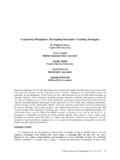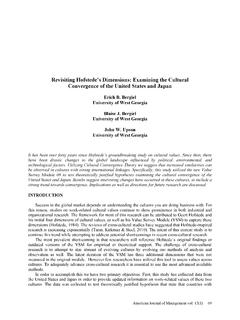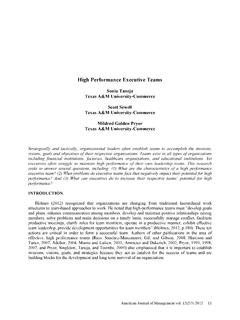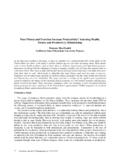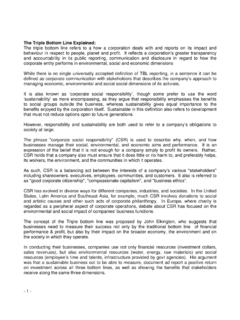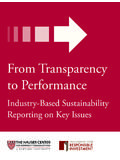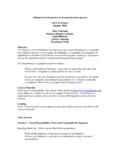Transcription of McDonald’s and the Triple Bottom Line: A Case Study of ...
1 McDonald s and the Triple Bottom line : A case Study of corporate sustainability Ben Rowley University of Central Arkansas Mark E. McMurtrey University of Central Arkansas In the not too distant past, people would grow a significant portion of their own food. But in much of today s developed economies, sustenance is simply bought at retail outlets. The supply chain management and its linkage to quality food production and innovation at McDonald s will be examined. Specific examples of modifications in supply chain strategy as they extend into new market areas globally (in India) will be discussed.
2 The efforts of the company to satisfy the demands of the Triple Bottom line will be addressed, including some basics of corporate responsibility, successes, and where problems still exist for McDonald s. INTRODUCTION The basics of understanding how food is obtained, from farm to fork, is an interesting prospect. In the not too far distant past, many individuals would grow a significant portion of their own produce. Some might have even raised and maintained animals for their meat and other food products, such as milk.
3 But in much of today s developed economies, food is simply bought at retail outlets and, to a much lesser extent, at local farmer s markets. These outlets include supermarkets, with an astounding variety of fresh food products readily at hand, and restaurant retail outlets such as McDonald s. The services provided, and standards enforced, in such an operation is worth of scholarly inquiry. A variety of businesses operate in the supply end for these retailers, producing the food that will eventually be sold.
4 Distributors often serve as middlemen in the process, acting as commodities agents between producers and retailers. Global industrialization has led to the concentration of the supply end of the food production/distribution business, much like what has been observed for other industries ( automobile production, shipbuilding, and chemicals) (Lillford, 2008). In fact, it could be predicted that the immediate future will result in several general trends in the food supply chain business based on these previous events in other industries.
5 For example, primary production will become further concentrated to areas with best practices, capital, climate and soils for best yields. Processers will move operations to regions with cheaper labor and better markets. Retailers will branch out into areas with the most growth potential. Global players will form strategic alliances with each other and potentially become less technically innovative, relying instead on their sheer scale difference to overcome lesser players (Lillford, 2008). Journal of Strategic Innovation and sustainability Vol.
6 11(1) 2016 33 While these predictions are important to understanding the possible future of food supply chains, it s also important to consider the logistics side of supplying food. As food is a perishable commodity, proper handling and long-distance cold chains are important to avoid waste and product loss (Taylor and Fearne, 2006). Understanding and assessing variability in consumer demand is also critically important to avoid spoiled unsold product. Proper alignment of activity along the production chain with consumer demand, including timeliness of order placement, order delivery, stocking, and real-time assessment of stock present and demand for new stock, are all critical to maximizing profit and minimizing waste in the food retail business (Taylor and Fearne, 2006).
7 This topic is clearly very large and very diverse, and most likely beyond the scope of a small research paper such as this. As such, this paper will focus on the global retail fast-food corporation McDonald s. The supply chain management and its linkage to quality food production and innovation in this corporation will be examined. Specific examples of modifications in supply chain strategy as McDonald s extends into new market areas globally (in India) will be discussed. The efforts of the company to satisfy the demands of the Triple Bottom line will be addressed, including some basics of corporate responsibility, successes, and where problems still exist for McDonald s.
8 While this paper will not be exhaustively comprehensive on the topic, it should still provide an overview of the good and the bad of McDonald s supply chain management and overall corporate responsibility measures. MCDONALD S AS A TOP GLOBAL FOOD SUPPLY CHAIN McDonald s ranked #3 on the 2012 Gartner s Supply Chain Top 25 list. This list has been published since 2004, and is ranked based on the idea of demand-driven leadership. The model used, as described by Gartner s revolves around three basic areas: Supply management, Demand management, and Product management.
9 McDonald s first earned its spot on the list in 2010, and has moved up the list in each subsequent year. The overall composite score for this listing involves opinion voting, three-year weighted ROA, inventory turns, and three-year weighted revenue growth (Hofman and Aronow, 2012). While each company on this ranked list deals with its logistics and demands differently, the authors cite several commonalities among the top 25. These key characteristics include four basic characteristics: 1.) an outside-in focus, 2.
10 Embedded innovation in supply chain, 3.) extended supply chains as networks, and 4.) being excellence addicts (Hofman and Aronow, 2012). Examining McDonald s specifically for each of these four characteristics is telling. An outside-in focus means designing a supply chain with the end product or consumer in mind. To this end, McDonald s routinely involves its testing kitchens and marketing staff at its corporate headquarters with its suppliers and its customers. This is termed the company s three-legged stool approach (Petrak, 2005).

